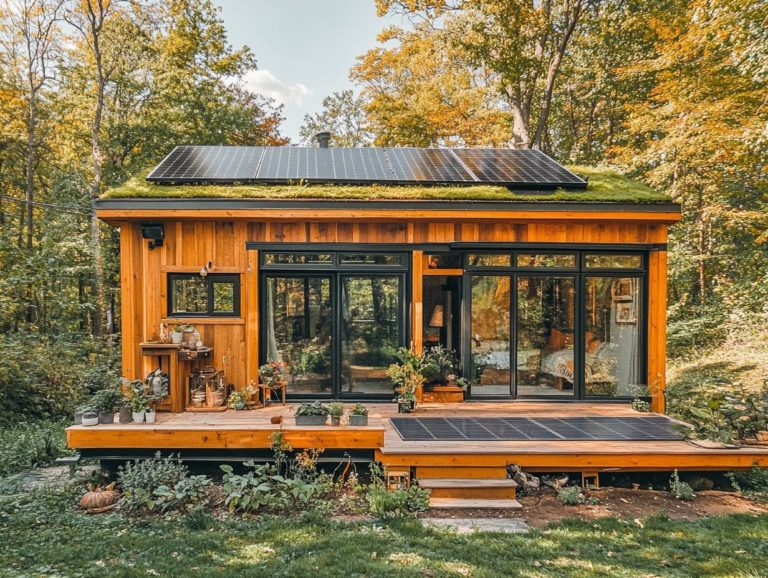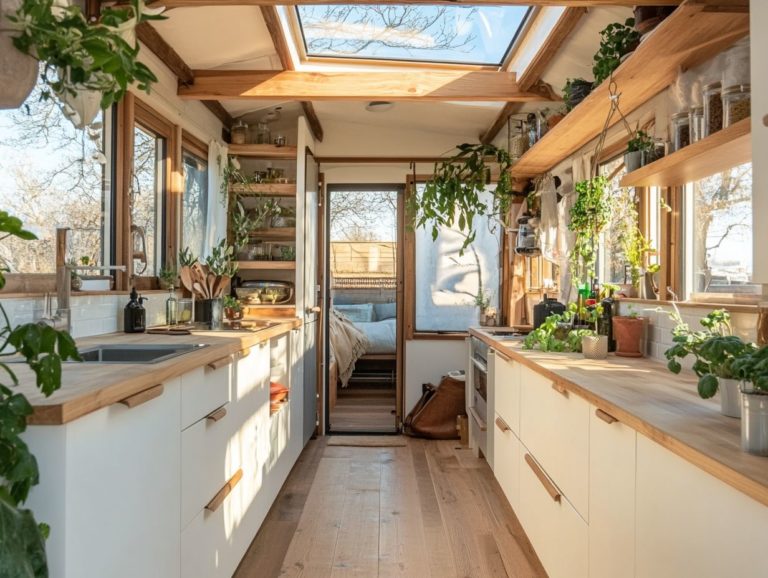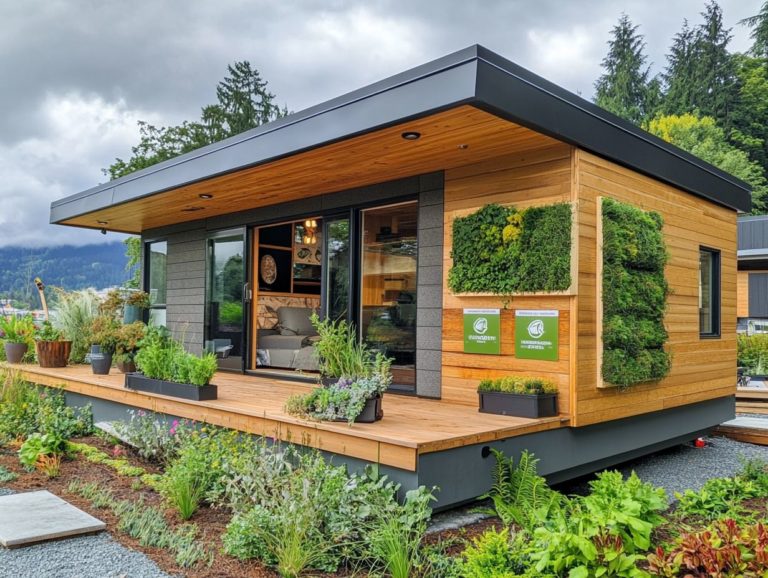Reclaimed Wood: A Sustainable Choice for Tiny Houses
Reclaimed wood has emerged as a favored option for tiny house enthusiasts, marrying sustainability with an undeniable charm rooted in minimalist lifestyles.
This material carries a rich history and presents significant environmentally friendly advantages when incorporated into construction.
Not only does it infuse character into your tiny home, it also plays a vital role in reducing waste, aligning with the tiny home movement.
From sourcing and selecting the perfect pieces to expert tips on working with reclaimed materials, you ll discover everything necessary to craft a beautiful, sustainable living space.
Contents [hide]
- Key Takeaways:
- What is Reclaimed Wood?
- Benefits of Using Reclaimed Wood in Tiny Houses
- How to Source and Select Reclaimed Wood
- Tips for Working with Reclaimed Wood
- Frequently Asked Questions
- What is reclaimed wood and why is it a sustainable choice for tiny houses?
- Can reclaimed wood be used for all aspects of a tiny house?
- Is reclaimed wood more expensive than new lumber?
- How does using reclaimed wood contribute to sustainability?
- Are there any downsides to using reclaimed wood in a tiny house?
- Where can I find sources of reclaimed wood for my tiny house project?
Key Takeaways:
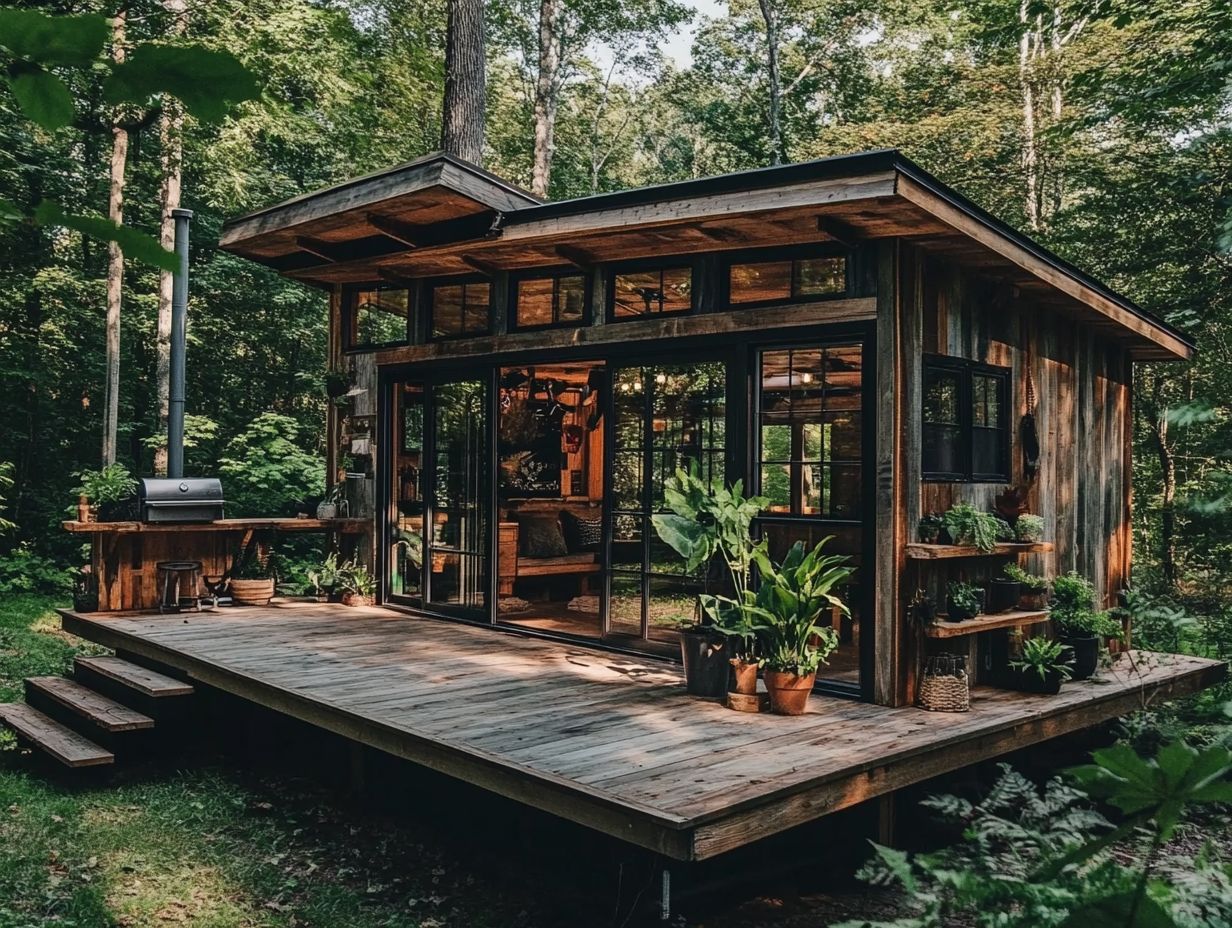
- Reclaimed wood adds unique beauty and promotes sustainability by reducing demand for new lumber.
- When sourcing reclaimed wood, consider factors like wood quality and finish. Knowing where to find options like TerraMai and salvaged wood can simplify the process.
- Working with reclaimed wood requires special attention. Proper preparation and treatment, along with eco-friendly building practices, can ensure the longevity of your tiny house.
What is Reclaimed Wood?
Reclaimed wood is a premium building material. It s derived from vintage structures, furniture, and other items that are thoughtfully repurposed for new construction projects, embodying sustainable lifestyles. This sustainable choice offers an environmentally friendly alternative to traditional lumber, allowing you to contribute to forest preservation while enhancing your aesthetic sensibilities.
This practice aligns beautifully with the tiny house movement, championing eco-friendly practices and minimalist living. Organizations like Havenn Tiny Houses exemplify this ethos, crafting unique flooring options for tiny houses that resonate with the charm of reclaimed materials.
Definition and History
Reclaimed wood refers to lumber that has been salvaged from old buildings, barns, and other structures. This imbues it with a rich history that enhances its aesthetic appeal in construction and design.
This practice of repurposing timber has roots that stretch back centuries, with early examples found in various cultures. For instance, traditional Japanese architecture often utilized aged wood for its remarkable durability and distinctive character, showcasing effective design strategies.
In Europe, old ships were transformed into flooring and furniture, allowing historical materials to be reborn in new forms. As environmental consciousness has surged, reclaimed wood has become a cornerstone of modern eco-friendly construction practices, embodying a sustainable lifestyle that emphasizes resource conservation and waste reduction. Additionally, understanding the impact of sustainable materials on tiny house value can further enhance the benefits of these practices.
By embracing reclaimed wood, you not only contribute to a greener planet but also celebrate the stories and craftsmanship woven into each unique piece, reinforcing your commitment to taking care of the environment and considering using recycled materials in tiny house designs.
Benefits of Using Reclaimed Wood in Tiny Houses
Using reclaimed wood in tiny houses offers amazing benefits you won t want to miss! You ll enjoy the sustainability it brings and the distinctive aesthetics of materials like old-growth timber that set your space apart.
Plus, the reduced environmental impact aligns perfectly with your commitment to minimalist living and eco-friendly building practices, including rainwater harvesting. Exploring sustainable building materials for tiny homes is an ideal choice for anyone looking to blend style with responsibility.
Sustainability and Environmental Impact
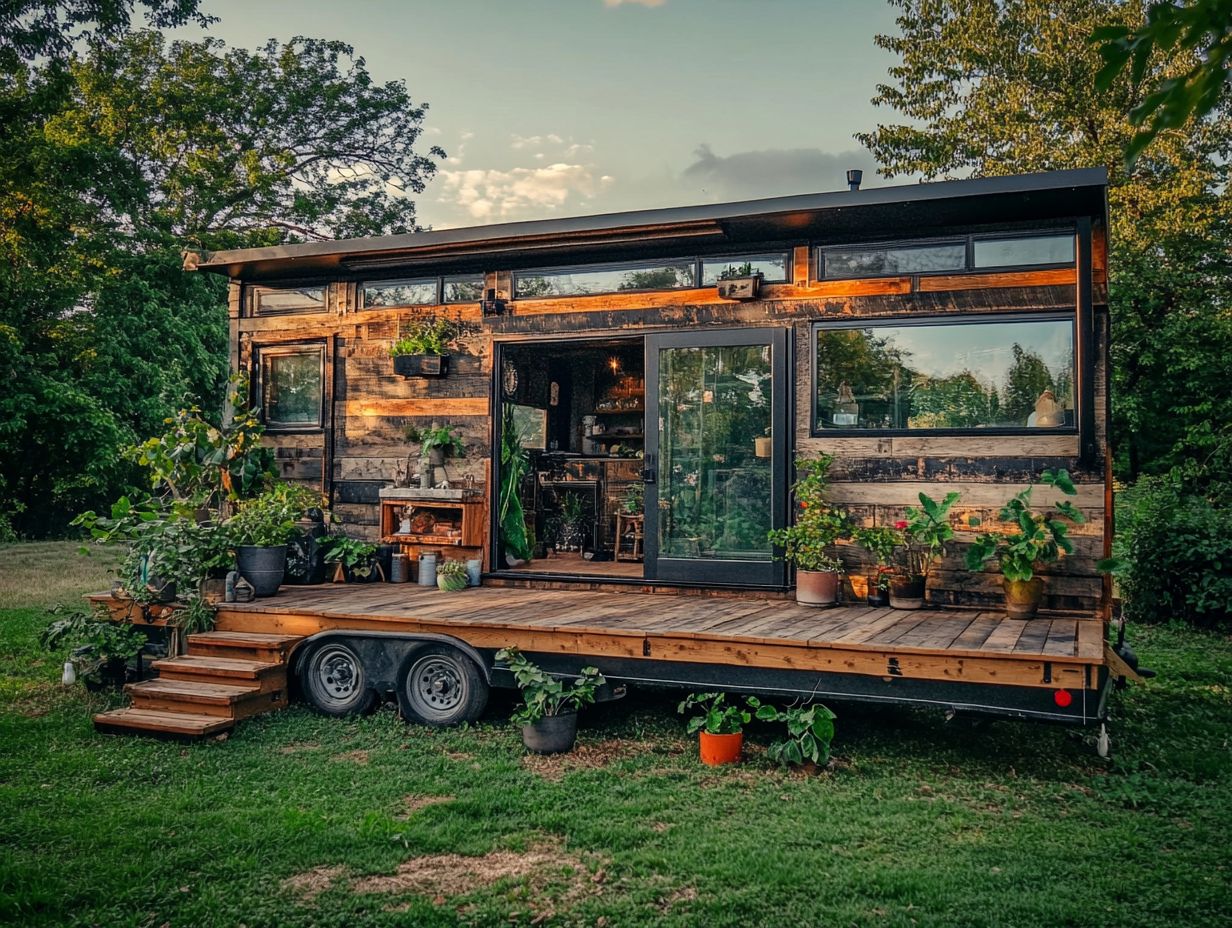
Reclaimed wood plays a pivotal role in sustainability by reducing the need for new timber harvesting. This minimizes deforestation and its harmful effects on the environment, contributing to eco-conscious living.
This approach helps preserve essential ecosystems and cuts down on carbon emissions associated with the logging industry. By using reclaimed wood in your construction projects, you make a bold statement for eco-friendly living while exploring The Future of Sustainable Materials in Tiny Housing to craft unique and stylish environments.
Take tiny houses, for instance. They often utilize reclaimed wood for flooring, walls, and even furniture. This highlights the wood’s rustic charm and remarkable durability. Choosing materials with a history adds character to these compact spaces and embodies a lifestyle centered on resourcefulness and minimalism. Incorporating sustainable design practices for tiny houses further enhances their appeal.
By embracing such materials in tiny house construction, you promote sustainability and cultivate a deeper connection between the occupants and their living space.
Unique Aesthetic and Character
Reclaimed wood adds a unique aesthetic and character to tiny houses, infusing them with a rustic charm that new lumber simply can’t replicate. Each structure becomes distinct and rich with history.
Each piece of reclaimed wood has a fascinating story to tell, perhaps being salvaged from old barns or factories. By integrating reclaimed wood into design elements like accent walls, countertops, and shelving, you create a tactile experience that invites warmth and cultivates an inviting atmosphere, while also considering the role of sustainability in tiny house construction.
Even small features, such as reclaimed wood beams or custom cabinetry, can transform an otherwise simple space into a cozy retreat. This showcases rustic charm and seamlessly blends sustainability with style. For those considering building a tiny home, exploring the best materials for tiny house construction can help you choose unique pieces to reduce your environmental footprint and enhance your home’s charm.
How to Source and Select Reclaimed Wood
When sourcing and selecting reclaimed wood, engage in a careful selection of various factors. This ensures the materials fulfill the strength and design goals of tiny houses while aligning with regulatory compliance and eco-friendly building practices.
Where to Find Reclaimed Wood
You can discover reclaimed wood in various places, such as architectural salvage yards, local lumber mills, and websites dedicated to eco-friendly building materials, including Amazon, Google, and HBO.
Community marketplaces like Craigslist and Facebook Marketplace often feature local sellers offering reclaimed materials. Don’t overlook antique shops and estate sales; you might stumble upon unique treasures with stories waiting to be told.
When considering this sustainable choice, it’s essential to verify the authenticity and quality of the materials. Look for certifications or labels that ensure they meet eco-conscious standards. Take a moment to inquire about the wood’s origin to ensure it aligns with your commitment to environmental responsibility and navigating challenges of using reclaimed materials.
A thorough assessment can lead you to an eco-friendly choice that benefits the planet and enhances the beauty of any space.
Factors to Consider when Choosing Reclaimed Wood

When selecting reclaimed wood for your construction projects, it’s vital to consider several factors, such as its structural integrity and the presence of non-toxic insulation.
Also, consider any treatments needed to ensure durability and safety, including **passive solar design**.
You should be vigilant about identifying potential contaminants that may have seeped in over time, like mold or pests that could jeopardize the wood’s safety and usability.
Testing becomes essential here not only to assess the wood’s strength but also to understand its treatment history, which can indicate whether it aligns with **eco-friendly practices**.
Environmental compatibility is crucial; the right reclaimed wood can significantly enhance your sustainability efforts.
Once installed, regular maintenance, including careful cleaning and refinishing, will help preserve both its structural soundness and aesthetic charm, ensuring it remains a stunning feature of your design for years to come.
Tips for Working with Reclaimed Wood
When you work with reclaimed wood, it’s essential to employ specific tips and techniques for preparing, treating, and maintaining the material.
Consider including **design strategies** for **building methods** to ensure that its unique qualities are preserved while achieving optimal performance in your tiny house construction.
Attention to detail in these processes not only enhances the wood s natural beauty but also contributes to the overall integrity and durability of your project.
This reinforces the principles of **environmentally friendly** building.
Preparing and Treating Reclaimed Wood
Preparing and treating reclaimed wood involves several essential steps that elevate the material to its full potential.
Start by cleaning the wood to remove any contaminants.
Be sure to choose finishes that are eco-friendly and non-toxic, aligning with modern **building methods** to preserve its integrity.
Before you dive into the treatment process, take a moment to assess the wood s condition.
Look for any signs of decay or damage that might require attention.
A gentle, biodegradable cleaner will effectively strip away dirt without harming the wood fibers, promoting good **energy efficiency** during the cleaning process.
Once the wood is clean, you can apply a non-toxic treatment, such as natural oils or eco-friendly waxes.
This not only protects the surface but also allows the wood to breathe.
Ensure your treatments meet safety standards while also addressing the need for **non-toxic insulation**.
Doing so guarantees not just durability but also promotes healthy indoor air quality, making reclaimed wood a truly sustainable choice for any project you undertake.
Best Practices for Construction and Maintenance
Implementing best practices for the construction and maintenance of reclaimed wood is essential for ensuring longevity, energy efficiency, and structural reliability in tiny house design.
By carefully selecting high-quality reclaimed materials, you not only achieve aesthetic appeal but also promote sustainability.
Integrating strong joints like mortise and tenon or dovetails adds enhanced stability, ensuring your structure stands the test of time.
Energy-efficient designs, including proper insulation and the strategic use of reclaimed wood for thermal mass, can seamlessly complement your eco-friendly building practices.
Regular maintenance is crucial for preserving the wood; treat it with appropriate finishes and check for wear and tear.
This will preserve both the quality and visual charm of the materials, ensuring that the beauty of reclaimed wood continues to shine for years to come.
Frequently Asked Questions
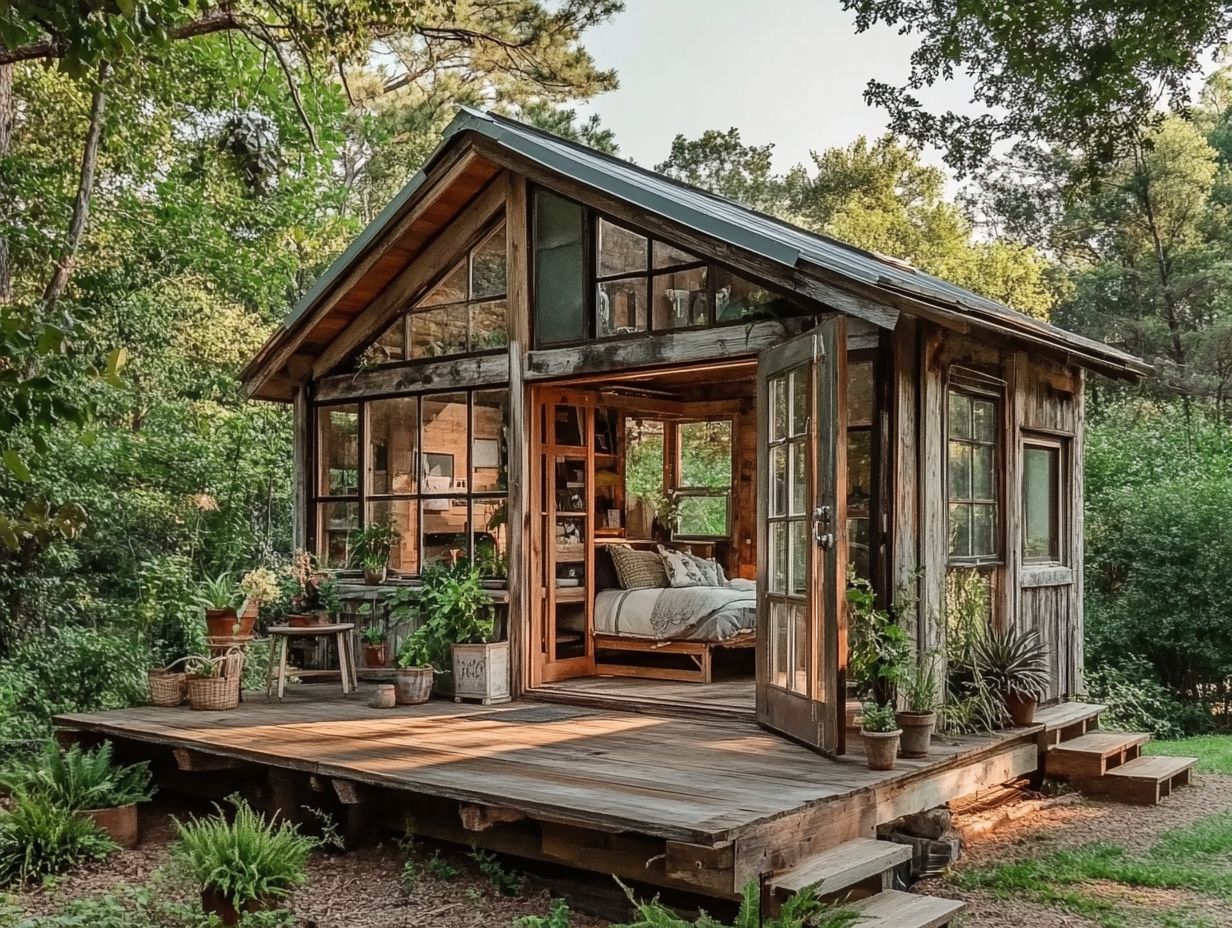
What is reclaimed wood and why is it a sustainable choice for tiny houses?
Reclaimed wood is salvaged from old buildings, barns, or other structures. It s repurposed for construction or furniture making, making it a sustainable choice for tiny houses.
Can reclaimed wood be used for all aspects of a tiny house?
Yes, reclaimed wood can be used in various parts of a tiny house, including flooring, walls, ceilings, and even furniture. It provides a rustic and unique aesthetic while also being environmentally friendly.
Is reclaimed wood more expensive than new lumber?
The cost of reclaimed wood can vary depending on the source and availability. In general, it may be slightly more expensive than new lumber.
However, the long-term benefits of using reclaimed wood, such as reduced environmental impact and durability, make it a worthwhile investment.
How does using reclaimed wood contribute to sustainability?
Using reclaimed wood helps reduce cutting down trees, which is a major contributor to climate change. It also keeps old materials out of landfills and reduces the need for energy and resources to produce new lumber.
Are there any downsides to using reclaimed wood in a tiny house?
One potential downside is that reclaimed wood may have imperfections or previous nail holes that need to be addressed during installation. It may also require more maintenance and upkeep compared to new lumber.
However, these factors can also add to the unique character of the wood.
Where can I find sources of reclaimed wood for my tiny house project?
There are many companies and organizations that specialize in sourcing and selling reclaimed wood. Local salvage yards, antique shops, and online marketplaces can also be great places to find reclaimed wood for your tiny house project.
Be sure to research your options thoroughly to find the perfect wood for your project!

